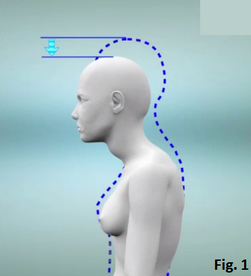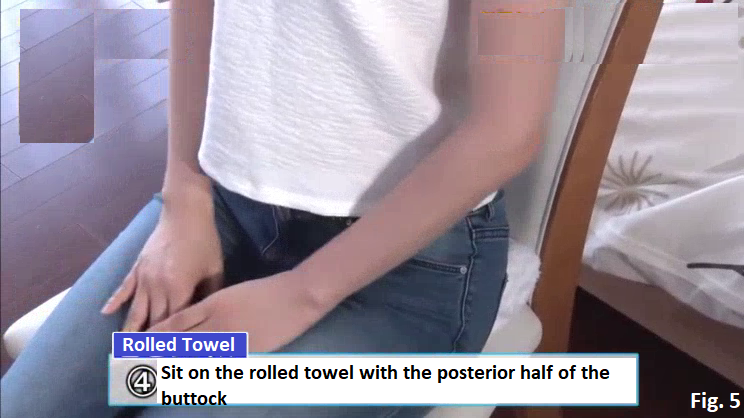|
Stumbling and falling can cause the fracture of the femur, leaving a disability in the lower body or shortening healthy life expectancy by bedridden life.
Based on previously established common sense, declining of the lower body was the cause of stumbling and falling. But the weakness of the muscles in the lower body was not the only cause of stumbling and falling. How to check whether to have another cause of stumbling and falling Check your stride when you usually walk (Fig. 1). If your stride is shorter than your height multiplied by 0.45, you may have another cause of stumbling and falling. A person whose stride is short has the deformed spine. A healthy person’s spine should be S-shaped, but the person whose stride is short has straight spine. Because the spine is S-shaped, when we jump, walk or run, the spine absorbs the shock from the movements like a spring and prevents putting a strain to the body. But as we age, the front side of bones and disks around the low back are worn down, making the spine straight (Fig. 2). The straight spine makes a slouching posture, contracts the abdominal muscles and extends the back muscles (Fig. 3). If the condition continues for a long time, the muscles become tight and don’t return to the original state, and the deformation of the spine gets worse. Why does the straight spine shorten the stride? When you slouch, your pelvis gets tilted backward and you need to bend your knees to balance your body. That makes lifting up your legs and waling forward difficult so that you need to shuffle with short strides. How to improve a straight spine (1) Fold a towel 3 times and roll it. (2) Secure both ends with rubber bands. (3) Put the rolled towel at the buttocks’ side on a chair (Fig. 4). (4) Sit on the rolled towel with the posterior half of the buttocks (Fig. 5). This makes your pelvis tilted forward and makes it easy to straight your back (Fig. 6). If you continues this sitting method, your abdominal muscles will extend, your back muscles will contract and the S-shape of your spine can be recovered. Experiment A 56 year-old male who slouched and whose stride was less than the referenced value tried to sit on a rolled towel for a week. His posture became straighter when he walked and his stride was improved by 4 inches.
0 Comments
 You might think stumbling is nothing serious. But if elderly people whose bones are weak stumble and fall, it can result in fracture. If the fracture happens in the hip joint, you may have to have a surgery and can become bedridden. The cause of stumbling considered so far was weakness of muscles in the lower body. It is said that 1 % of the muscle is lost every year from the age of 30s.That makes easy to stumble. But a new cause of stumbling was discovered this year. People who easily stumble can’t stand long with their one leg even if they do exercises regularly. What they have in common is that their height is shorter than when they were young. (Fig. 1) If your height is shorter by 2 cm (about 1 inch) compared to when you were young, you have more risk to stumble and fall. Our height is gradually shorter with age. The major causes of shortening of height are (1) Compression fracture of the spines (2) Thinning of intervertebral disks Shortening of height causes a bad posture with rounded back and that makes you easy to lose their balance, leading to stumbling. But there is another major cause to promote shortening of height. That is weakening of muscles in the back. When you have firm muscles in your back, you can keep a good posture by pulling the spine backward. When your back muscles become weak with age, your body is pulled forward by gravity, but you can’t pull the spine backward. Rounded back also promotes the weakening of the back muscles. Weakening of the back muscles applies burden to the spine and disks, rounding and tightening the back more. Rounded back caused by weakening of back muscles causes shortening of height. There is a supporter to experience rounded back. If you wear this supporter, you have to walk with a stoop and your stride becomes short and it becomes difficult to lift up your legs, making easy to stumble. How to check the strength of your back muscles 1. Stand in front of a wall and touch your heel on the wall. 2. Touch your back and buttocks on the wall and look forward. 3. At this point, if the back of your head touches the wall, it is good, but if the back of your head doesn’t touch the wall, you have slouching posture due to weakening of the back muscles and there is a possibility that your height is shorter by more than 2 cm (1 inch). (Fig. 2) How to strengthen your back muscles and prevent stumbles 1. Upper body raising exercise (Fig. 3 & 4) (1) Lie face down. (2) Extend your elbows slowly raising your upper body. (3) Keep the posture for 5 seconds (if possible 10 seconds). (4) Repeat this exercise 3 times. This exercise stretches tightened back muscles. 2. Back muscle exercise (Fig. 5 &6) (1) Prepare a pillow or a cushion. (2) Lie face down placing a pillow under your navel with your hands clasped around your low back. (3) Raise your upper back as you are. It is okay if you can raise your chest a little bit. (4) Keep the posture for 5 seconds (if possible 10 seconds). (5) Repeat this exercise 5 times. It is effective to do the above 2 exercises twice a day in the morning and at night every day. Experiment How much balance ability can be improved by doing the stumble prevention exercises for a week? 67 years old woman whose height was shortened by 3 cm (150 cm to 146.9 cm) and whose one leg standing test was 24 seconds attended the experiment. She often stumbled on a small bump and felt difficult to climb up and down stairs. After 1 week stumble prevention exercises, one leg standing test became 1 minutes 23 seconds from 24 seconds. That means that her balance ability was improved. Also she became able to climb up stairs more smoothly because she could lift her legs more easily. |
IchiroThis Blog is for a memo of my clinical realizations, information about health I have learned recently and update information. Archives
April 2024
Categories
All
|











 RSS Feed
RSS Feed